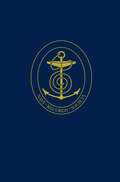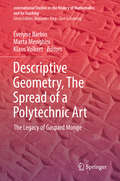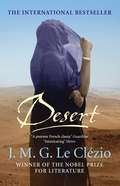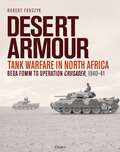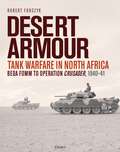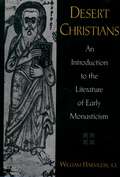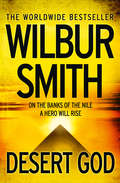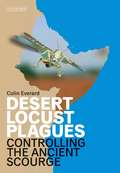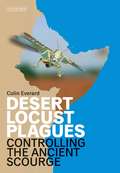- Table View
- List View
Descriptive Archaeoastronomy and Ancient Indian Chronology
by Amitabha GhoshThis book presents the basic fundamentals of descriptive archaeoastronomy and its application to the astronomical descriptions found in ancient Indian scriptures. Archaeoastronomy is a branch of positional astronomy that helps to determine the epochs of ancient astronomical alignments and special astronomical events. In this book, only the descriptions of special stellar alignments and events found in ancient texts can identify the antiquity of the descriptions. India possesses a large volume of ancient scriptures like Vedas and Puranas which contain many astronomical descriptions as in ancient India positional astronomy was well developed. The antiquities of these texts are determined through archaeoastronomical techniques. Major events like Mahabharata War are dated and using these dates a chronology of ancient India is determined. The astronomically determined chronology is compared with the results from various archaeological, palaeoclimatological, geological and genealogical investigations of ancient India. This introductory book interests readers interested in unveiling the mystery involved with the protohistory of this ancient civilization.
Descriptive Catalogue of the Garrett Collection: (Persian, Turkish, Indic) (PDF)
by Philip K. HittiVolume 5 of the Princeton Oriental Texts.Originally published in 1939.The Princeton Legacy Library uses the latest print-on-demand technology to again make available previously out-of-print books from the distinguished backlist of Princeton University Press. These editions preserve the original texts of these important books while presenting them in durable paperback and hardcover editions. The goal of the Princeton Legacy Library is to vastly increase access to the rich scholarly heritage found in the thousands of books published by Princeton University Press since its founding in 1905.
A Descriptive Catalogue of the Naval Manuscripts in the Pepysian Library: Vol. I
by J.R. TannerSamuel Pepys (1633-1703) made a significant contribution to British history by his work as a naval administrator, and he bequeathed to Magdalen College, Cambridge its greatest treasure – his library, a unique collection of 3,000 books and manuscripts, still preserved as he left it. There are 250 volumes of manuscripts and these NRS volumes published selected documents from the collection.In this volume Tanner gives a lengthy general introduction to Pepys’s career as a naval administrator and to the papers he left at his death, and also prints from them lists of ships and officers from 1660 to 1688.
A Descriptive Catalogue of the Naval Manuscripts in the Pepysian Library: Vol. I
by J.R. TannerSamuel Pepys (1633-1703) made a significant contribution to British history by his work as a naval administrator, and he bequeathed to Magdalen College, Cambridge its greatest treasure – his library, a unique collection of 3,000 books and manuscripts, still preserved as he left it. There are 250 volumes of manuscripts and these NRS volumes published selected documents from the collection.In this volume Tanner gives a lengthy general introduction to Pepys’s career as a naval administrator and to the papers he left at his death, and also prints from them lists of ships and officers from 1660 to 1688.
Descriptive Geometry, The Spread of a Polytechnic Art: The Legacy of Gaspard Monge (International Studies in the History of Mathematics and its Teaching)
by Évelyne Barbin Marta Menghini Klaus VolkertThis book seeks to explore the history of descriptive geometry in relation to its circulation in the 19th century, which had been favoured by the transfers of the model of the École Polytechnique to other countries. The book also covers the diffusion of its teaching from higher instruction to technical and secondary teaching. In relation to that, there is analysis of the role of the institution – similar but definitely not identical in the different countries – in the field under consideration. The book contains chapters focused on different countries, areas, and institutions, written by specialists of the history of the field. Insights on descriptive geometry are provided in the context of the mathematical aspect, the aspect of teaching in particular to non-mathematicians, and the institutions themselves.
Descriptive Psychology and Historical Understanding
by W. DiltheyPerhaps no philosopher has so fully explored the nature and conditions of historical understanding as Wilhelm Dilthey. His work, conceived overall as a Critique of Historical Reason and developed through his well-known theory of the human studies, provides concepts and methods still fruitful for those concerned with analyzing the human condition. Despite the increasing recognition of Dilthey's contributions, relati vely few of his writings have as yet appeared in English translation. It is therefore both timely and useful to have available here two works drawn from different phases in the development of his philosophy. The "Ideas Concerning a Descriptive and Analytic Psychology" (1894), now translated into English for the first time, sets forth Dilthey's programma tic and methodological viewpoints through a descriptive psychology, while "The Understanding of Other Persons and Their Expressions of Life" (ca. 1910) is representative of his later hermeneutic approach to historical understanding. DESCRIPTIVE PSYCHOLOGY AND THE HUMAN STUDIES Dilthey presented the first mature statement of his theory of the human studies in volume one of his Einleitung in die Geisteswissenschaften (Introduction to the Human Studies), published in 1883. He argued there that for the proper study of man and history we must eschew the metaphysical speculation of the absolute idealists while at the same time avoiding the scientistic reduction of positivism.
The Desecularisation of the City: London’s Churches, 1980 to the Present (Routledge Studies in Religion)
by David Goodhew Anthony-Paul CooperMajor cities have long been seen as centres of secularisation. However, the number of congregations in London grew by 50% between 1979 and the present. London’s churches have been characterised more by growth than by decline in the decades since 1980. The Desecularisation of the City provides the first academic survey of churches in London over recent decades, linking them to similar developments in other major cities across the West. Produced by a large team of scholars from a range of disciplines, this volume offers a striking and original portrait of congregational life in London since 1980. Seventeen chapters explore the diverse localities, ethnicities and denominations that make up the church in contemporary London. The vitality of London’s churches in the last four decades shows that secularisation is far from inevitable in the cities of the future. This study necessitates a significant reassessment of the dominant academic portrayal of Christianity in Britain and the West, which has, mostly, depicted cities as secular spaces within a secularising culture. It will be of great interest to scholars working across a wide range of disciplines, including history, sociology, religious studies and theology.
The Desecularisation of the City: London’s Churches, 1980 to the Present (Routledge Studies in Religion)
by David Goodhew Anthony-Paul CooperMajor cities have long been seen as centres of secularisation. However, the number of congregations in London grew by 50% between 1979 and the present. London’s churches have been characterised more by growth than by decline in the decades since 1980. The Desecularisation of the City provides the first academic survey of churches in London over recent decades, linking them to similar developments in other major cities across the West. Produced by a large team of scholars from a range of disciplines, this volume offers a striking and original portrait of congregational life in London since 1980. Seventeen chapters explore the diverse localities, ethnicities and denominations that make up the church in contemporary London. The vitality of London’s churches in the last four decades shows that secularisation is far from inevitable in the cities of the future. This study necessitates a significant reassessment of the dominant academic portrayal of Christianity in Britain and the West, which has, mostly, depicted cities as secular spaces within a secularising culture. It will be of great interest to scholars working across a wide range of disciplines, including history, sociology, religious studies and theology.
Desegregating Chicago’s Public Schools: Policy Implementation, Politics, and Protest, 1965–1985 (Historical Studies in Education)
by Dionne DannsHighlighting the processes and missteps involved in creating and carrying out school desegregation policies in Chicago, Dionne Danns discusses the challenges of using the 1964 Civil Rights Act to implement school desegregation and the resultant limitations and effectiveness of government legislative power in bringing about social change.
Desegregation State: College Writing Programs after the Civil Rights Movement
by Annie S. MendenhallThe only book-length study of the ways that postsecondary desegregation litigation and policy affected writing instruction and assessment in US colleges, Desegregation State provides a history of federal enforcement of higher education desegregation and its impact on writing programs from 1970 to 1988. Focusing on the University System of Georgia and two of its public colleges in Savannah, one a historically segregated white college and the other a historically Black college, Annie S. Mendenhall shows how desegregation enforcement promoted and shaped writing programs by presenting literacy remediation and testing as critical to desegregation efforts in southern and border states. Formerly segregated state university systems crafted desegregation plans that gave them more control over policies for admissions, remediation, and retention. These plans created literacy requirements—admissions and graduation tests, remedial classes, and even writing centers and writing across the curriculum programs—that reshaped the landscape of college writing instruction and denied the demands of Black students, civil rights activists, and historically Black colleges and universities for major changes to university systems. This history details the profound influence of desegregation—and resistance to desegregation—on the ways that writing is taught and assessed in colleges today. Desegregation State provides WPAs and writing teachers with a disciplinary history for understanding racism in writing assessment and writing programs. Mendenhall brings emerging scholarship on the racialization of institutions into the field, showing why writing studies must pay more attention to how writing programs have institutionalized racist literacy ideologies through arguments about student placement, individualized writing instruction, and writing assessment.
Desert
by J.M.G Le ClézioThe international bestseller, by the winner of the Nobel Prize for Literature 2008, available for the first time in English translation.Young Nour is a North African desert tribesman. It is 1909, and as the First World War looms Nour's tribe - the Blue Men - are forced from their lands by French colonial invaders. Spurred on by thirst, hunger, suffering, they seek guidance from a great spiritual leader. The holy man sends them even further from home, on an epic journey northward, in the hope of finding a land in which they can again be free. Decades later, an orphaned descendant of the Blue Men - a girl called Lalla - is living in a shantytown on the coast of Morocco. Lalla has inherited both the pride and the resilience of her tribe - and she will need them, as she makes a bid to escape her forced marriage to a wealthy older man. She flees to Marseilles, where she experiences both the hardships of immigrant life - as a hotel maid - and the material prosperity of those who succeed - when she becomes a successful model. And yet Lalla does not betray the legacy of her ancestors. In these two narratives set in counterpoint, Nobel Prize-winning novelist J. M. G. Le Clézio tells - powerfully and movingly - the story of the 'last free men' and of Europe's colonial legacy - a story of war and exile and of the endurance of the human spirit.
Desert Armour: Tank Warfare in North Africa: Beda Fomm to Operation Crusader, 1940–41
by Robert ForczykRobert Forczyk covers the development of armoured warfare in North Africa from the earliest Anglo-Italian engagements in 1940 to the British victory over the German Afrikakorps in Operation Crusader in 1941. The war in the North African desert was pure mechanized warfare, and in many respects the most technologically advanced theatre of World War II. It was also the only theatre where for three years British and Commonwealth, and later US, troops were in constant contact with Axis forces. World War II best-selling author Robert Forczyk explores the first half of the history of the campaign, from the initial Italian offensive and the arrival of Rommel's Panzergruppe Afrika to the British Operation Crusader offensive that led to the relief of Tobruk. He examines the armoured forces, equipment, doctrine, training, logistics and operations employed by both Allied and Axis forces throughout the period, focusing especially on the brigade and regimental level of operations.Fully illustrated throughout with photographs, profile artwork and maps, and featuring tactical-level vignettes and appendices analysing tank data, tank deliveries in-theatre and orders of battle, this book goes back to the sources to provide a new study of armoured warfare in the desert.
Desert Armour: Tank Warfare in North Africa: Beda Fomm to Operation Crusader, 1940–41
by Robert ForczykRobert Forczyk covers the development of armoured warfare in North Africa from the earliest Anglo-Italian engagements in 1940 to the British victory over the German Afrikakorps in Operation Crusader in 1941. The war in the North African desert was pure mechanized warfare, and in many respects the most technologically advanced theatre of World War II. It was also the only theatre where for three years British and Commonwealth, and later US, troops were in constant contact with Axis forces. World War II best-selling author Robert Forczyk explores the first half of the history of the campaign, from the initial Italian offensive and the arrival of Rommel's Panzergruppe Afrika to the British Operation Crusader offensive that led to the relief of Tobruk. He examines the armoured forces, equipment, doctrine, training, logistics and operations employed by both Allied and Axis forces throughout the period, focusing especially on the brigade and regimental level of operations.Fully illustrated throughout with photographs, profile artwork and maps, and featuring tactical-level vignettes and appendices analysing tank data, tank deliveries in-theatre and orders of battle, this book goes back to the sources to provide a new study of armoured warfare in the desert.
Desert Borderland: The Making of Modern Egypt and Libya
by Matthew H. EllisDesert Borderland investigates the historical processes that transformed political identity in the easternmost reaches of the Sahara Desert in the half century before World War I. Adopting a view from the margins—illuminating the little-known history of the Egyptian–Libyan borderland—the book challenges prevailing notions of how Egypt and Libya were constituted as modern territorial nation-states. Matthew H. Ellis draws on a wide array of archival sources to reconstruct the multiple layers and meanings of territoriality in this desert borderland. Throughout the decades, a heightened awareness of the existence of distinctive Egyptian and Ottoman Libyan territorial spheres began to develop despite any clear-cut boundary markers or cartographic evidence. National territoriality was not simply imposed on Egypt's western—or Ottoman Libya's eastern—domains by centralizing state power. Rather, it developed only through a complex and multilayered process of negotiation with local groups motivated by their own local conceptions of space, sovereignty, and political belonging. By the early twentieth century, distinctive "Egyptian" and "Libyan" territorial domains emerged—what would ultimately become the modern nation-states of Egypt and Libya.
Desert Christians: An Introduction to the Literature of Early Monasticism
by William HarmlessIn the fourth century, the deserts of Egypt became the nerve center of a radical new movement, what we now call monasticism. Groups of Christians-from illiterate peasants to learned intellectuals-moved out to the wastelands beyond the Nile Valley and, in the famous words of Saint Athanasius, made the desert a city. In so doing, they captured the imagination of the ancient world. They forged techniques of prayer and asceticism, of discipleship and spiritual direction, that have remained central to Christianity ever since. Seeking to map the soul's long journey to God and plot out the subtle vagaries of the human heart, they created and inspired texts that became classics of Western spirituality. These Desert Christians were also brilliant storytellers, some of Christianity's finest. This book introduces the literature of early monasticism. It examines all the best-known works, including Athanasius' Life of Antony, the Lives of Pachomius, and the so-called Sayings of the Desert Fathers. Later chapters focus on two pioneers of monastic theology: Evagrius Ponticus, the first great theoretician of Christian mysticism; and John Cassian, who brought Egyptian monasticism to the Latin West. Along the way, readers are introduced to path-breaking discoveries-to new texts and recent archeological finds-that have revolutionized contemporary scholarship on monastic origins. Included are fascinating snippets from papyri and from little-known Coptic, Syriac, and Ethiopic texts. Interspersed in each chapter are illustrations, maps, and diagrams that help readers sort through the key texts and the richly-textured world of early monasticism. Geared to a wide audience and written in clear, jargon-free prose, Desert Christians offers the most comprehensive and accessible introduction to early monasticism.
Desert Christians: An Introduction to the Literature of Early Monasticism
by William HarmlessIn the fourth century, the deserts of Egypt became the nerve center of a radical new movement, what we now call monasticism. Groups of Christians-from illiterate peasants to learned intellectuals-moved out to the wastelands beyond the Nile Valley and, in the famous words of Saint Athanasius, made the desert a city. In so doing, they captured the imagination of the ancient world. They forged techniques of prayer and asceticism, of discipleship and spiritual direction, that have remained central to Christianity ever since. Seeking to map the soul's long journey to God and plot out the subtle vagaries of the human heart, they created and inspired texts that became classics of Western spirituality. These Desert Christians were also brilliant storytellers, some of Christianity's finest. This book introduces the literature of early monasticism. It examines all the best-known works, including Athanasius' Life of Antony, the Lives of Pachomius, and the so-called Sayings of the Desert Fathers. Later chapters focus on two pioneers of monastic theology: Evagrius Ponticus, the first great theoretician of Christian mysticism; and John Cassian, who brought Egyptian monasticism to the Latin West. Along the way, readers are introduced to path-breaking discoveries-to new texts and recent archeological finds-that have revolutionized contemporary scholarship on monastic origins. Included are fascinating snippets from papyri and from little-known Coptic, Syriac, and Ethiopic texts. Interspersed in each chapter are illustrations, maps, and diagrams that help readers sort through the key texts and the richly-textured world of early monasticism. Geared to a wide audience and written in clear, jargon-free prose, Desert Christians offers the most comprehensive and accessible introduction to early monasticism.
Desert Edens: Colonial Climate Engineering in the Age of Anxiety (Histories of Economic Life #9)
by Philipp LehmannHow technological advances and colonial fears inspired utopian geoengineering projects during the late nineteenth and early twentieth centuries From the 1870s to the mid-twentieth century, European explorers, climatologists, colonial officials, and planners were avidly interested in large-scale projects that might actively alter the climate. Uncovering this history, Desert Edens looks at how arid environments and an increasing anxiety about climate in the colonial world shaped this upsurge in ideas about climate engineering. From notions about the transformation of deserts into forests to Nazi plans to influence the climates of war-torn areas, Philipp Lehmann puts the early climate change debate in its environmental, intellectual, and political context, and considers the ways this legacy reverberates in the present climate crisis.Lehmann examines some of the most ambitious climate-engineering projects to emerge in the late nineteenth and early twentieth centuries. Confronted with the Sahara in the 1870s, the French developed concepts for a flooding project that would lead to the creation of a man-made Sahara Sea. In the 1920s, German architect Herman Sörgel proposed damming the Mediterranean in order to geoengineer an Afro-European continent called &“Atlantropa,&” which would fit the needs of European settlers. Nazi designs were formulated to counteract the desertification of Eastern Europe and Central Asia. Despite ideological and technical differences, these projects all incorporated and developed climate change theories and vocabulary. They also combined expressions of an extreme environmental pessimism with a powerful technological optimism that continue to shape the contemporary moment.Focusing on the intellectual roots, intended effects, and impact of early measures to modify the climate, Desert Edens investigates how the technological imagination can be inspired by pressing fears about the environment and civilization.
The Desert Fathers: Sayings of the Early Christian Monks
by Benedicta WardThe Desert Fathers were the first Christian monks, living in solitude in the deserts of Egypt, Palestine, and Syria. In contrast to the formalised and official theology of the "founding fathers" of the church, the Desert Fathers were ordinary Christians who chose to renounce the world and live lives of celibacy, fasting, vigil, prayer and poverty in direct and simple response to the gospel. Their sayings were first recorded in the 4th century and consist of spiritual advice, anecdotes and parables. The Desert Fathers' teachings and lives have inspired poetry, opera and art, as well as providing spiritual nourishment and a template for monastic life.
Desert God: An Egyptian Novel (The\egyptian Ser. #5)
by Wilbur SmithEx-slave. Philosopher. Chosen one.Taita has risen from nothing to become the most trusted man at the Pharaoh’s side. Only he can plot a mission that will return Egypt to its former glory. Only he can muster the force that can break the back of Egypt’s greatest enemy.
Desert in the Promised Land (Stanford Studies in Jewish History and Culture)
by Yael ZerubavelAt once an ecological phenomenon and a cultural construction, the desert has varied associations within Zionist and Israeli culture. In the Judaic textual tradition, it evokes exile and punishment, yet is also a site for origin myths, the divine presence, and sanctity. Secular Zionism developed its own spin on the duality of the desert as the romantic site of Jews' biblical roots that inspired the Hebrew culture, and as the barren land outside the Jewish settlements in Palestine, featuring them as an oasis of order and technological progress within a symbolic desert. Yael Zerubavel tells the story of the desert from the early twentieth century to the present, shedding light on romantic-mythical associations, settlement and security concerns, environmental sympathies, and the commodifying tourist gaze. Drawing on literary narratives, educational texts, newspaper articles, tourist materials, films, popular songs, posters, photographs, and cartoons, Zerubavel reveals the complexities and contradictions that mark Israeli society's semiotics of space in relation to the Middle East, and the central role of the "besieged island" trope in Israeli culture and politics.
Desert Kingdom: How Oil and Water Forged Modern Saudi Arabia
by Toby Craig JonesOil and water, and the science and technology used to harness them, have long been at the heart of political authority in Saudi Arabia. Oil’s abundance, and the fantastic wealth it generated, has been a keystone in the political primacy of the kingdom’s ruling family. The other bedrock element was water, whose importance was measured by its dearth. Over much of the twentieth century, it was through efforts to control and manage oil and water that the modern state of Saudi Arabia emerged. The central government’s power over water, space, and people expanded steadily over time, enabled by increasing oil revenues. The operations of the Arabian American Oil Company proved critical to expansion and to achieving power over the environment. Political authority in Saudi Arabia took shape through global networks of oil, science, and expertise. And, where oil and water were central to the forging of Saudi authoritarianism, they were also instrumental in shaping politics on the ground. Nowhere was the impact more profound than in the oil-rich Eastern Province, where the politics of oil and water led to a yearning for national belonging and to calls for revolution. Saudi Arabia is traditionally viewed through the lenses of Islam, tribe, and the economics of oil. Desert Kingdom now provides an alternative history of environmental power and the making of the modern Saudi state. It demonstrates how vital the exploitation of nature and the roles of science and global experts were to the consolidation of political authority in the desert.
Desert Kingdoms to Global Powers: The Rise of the Arab Gulf
by Rory MillerA lively analysis of the Arab Gulf states’ stunning rise to global power over the last half-century and of the daunting challenges they confront today Once just sleepy desert sheikdoms, the Arab Gulf states of Saudi Arabia, Oman, the United Arab Emirates, Qatar, Bahrain, and Kuwait now exert unprecedented influence on international affairs—the result of their almost unimaginable riches in oil and gas. In this book, Rory Miller, an expert in Gulf politics and international affairs, provides an accessible account of the achievements of these countries since the 1973 global oil crisis. He also investigates how the shrewd Arab Gulf rulers who have overcome crisis after crisis meet the external and internal challenges of the onrushing future. The Arab Gulf region has become an East–West hub for travel, tourism, sport, culture, trade, and finance. But can the autocratic regimes maintain stability at home and influence abroad as they deal with the demands of social and democratic reform? Miller considers an array of factors—Islamism, terrorism, the Arab Spring, volatile oil prices, global power dynamics, and others—to assess the future possibilities.
Desert Locust Plagues: Controlling the Ancient Scourge
by Robert A. Cheke Colin EverardFor thousands of years, humans have found themselves vulnerable to plagues of desert locusts. Some fifty countries in Africa, the Middle East and Asia have been ravaged, at one time or another, by huge, devouring swarms of locusts. With the consequent, often total, destruction of crops and grazing, widespread hunger and starvation ensued. Colin Everard's book takes as its geographical focus the Horn of Africa, an area which throughout history has suffered catastrophically from locust plagues. Based on his own extensive experience in the region, Everard describes one of the greatest (albeit unsung) triumphs of the twentieth century, namely, how the desert locust scourge has, at last, been virtually brought under control.
Desert Locust Plagues: Controlling the Ancient Scourge
by Colin Everard Robert A. ChekeFor thousands of years, humans have found themselves vulnerable to plagues of desert locusts. Some fifty countries in Africa, the Middle East and Asia have been ravaged, at one time or another, by huge, devouring swarms of locusts. With the consequent, often total, destruction of crops and grazing, widespread hunger and starvation ensued. Colin Everard's book takes as its geographical focus the Horn of Africa, an area which throughout history has suffered catastrophically from locust plagues. Based on his own extensive experience in the region, Everard describes one of the greatest (albeit unsung) triumphs of the twentieth century, namely, how the desert locust scourge has, at last, been virtually brought under control.
The Desert Nurse: A Grand Love Story Set In A Theatre Of War
by Pamela HartA grand love story set in a far-flung theatre of war, from the bestselling Australian author of The War Bride, Pamela HartAmid the Australian Army hospitals of World War I Egypt, two deeply determined individuals find the resilience of their love tested to its limits . . . It's 1911, and 21-year-old Evelyn Northey desperately wants to become a doctor. Her father forbids it, withholding the inheritance that would allow her to attend university. At the outbreak of World War I, Evelyn disobeys her father, enlisting as an army nurse bound for Egypt and the disastrous Gallipoli campaign.Under the blazing desert sun, Evelyn develops feelings for polio survivor Dr William Brent, who believes his disability makes him unfit to marry. For Evelyn, still pursuing her goal of studying medicine, a man has no place in her future. For two such self-reliant people, relying on someone else for happiness may be the hardest challenge of all . . .From the casualty tents, the fever wards and the operating theatres of the palace; through the streets of Cairo during Ramadan, to the parched desert and the grim realities of war, Pamela Hart, beloved bestselling Australian author of The War Bride, tells the heart-wrenching story of four years that changed the world forever.Praise for Pamela Hart'This book is heart-wrenching proof that all's NOT fair in love and war, especially for a lone woman in a man's world.' Valerie Parv on A Letter From Italy'Evokes WWI Sydney to the point where the reader can almost feel the salty wind blowing off the harbour as the troops are shipped out through the Heads' Books + Publishing on The Soldier's Wife'A Letter From Italy cements Pamela Hart as a go-to author when I want a love story to remember' Ausrom Today


